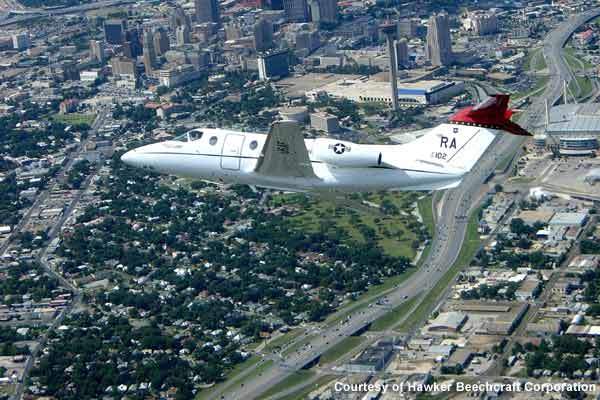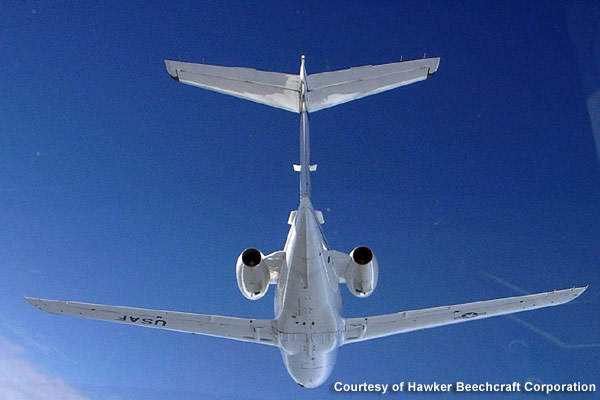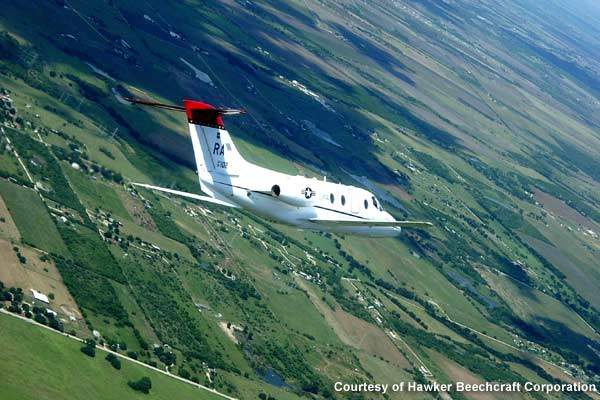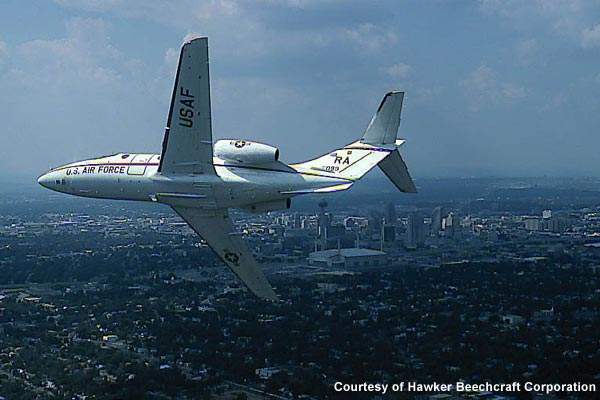The T-1 Jayhawk medium-range twin-engine trainer aircraft is manufactured by Raytheon and Hawker Beechcraft. It is employed by the US Air Force as a trainer aircraft. It is derived from the commercial Beechjet 400A aircraft and is used for advanced navigator training. It can be used in both high-altitude and low-altitude training operations.
The T-39 Sabreliner was the trainer aircraft previously deployed by the US Air Force to train student pilots. Its replacement, the Jayhawk, is used to train air force navigators and naval flight officers in low-level flight procedures during the intermediate jet phase of training.
The T-1 Jayhawk was first acquired by the US Air Force, and delivered to Reese Air Force Base, Texas, in January 1992, with student training beginning in 1993. It is used to train instructor pilots in all pilot training bases including Columbus AFB, Mississipi; Laughlin AFB, Texas; Vance AFB, and Okla and Randolph AFB, Texas.
The aircraft can accommodate a maximum of two crew, namely pilot and instructor. The advanced military version of the T-1, known as T-1A, completed one million flight hours with the US Government on 15 December 2005. Approximately 180 T-1 Jayhawk aircraft were delivered between 1992 to 1997.
Jayhawk orders and deliveries
The US Air Force announced a decision to procure the T-1 Jayhawk in February 1990 as part of its T-1A Jayhawk programme. Beech Aircraft (now Hawker Beechcraft) was initially contracted to deliver a total of 148 Jayhawks to the US Air Force at a cost of $648m.
In 1994, the USAF awarded another $127m contract to Beech Aircraft to supply 32 T-1A Jayhawks, increasing the total order to 180 aircraft and value to $755m. Beech Aircraft delivered the 180th T-1 Jayhawk to the USAF in 1997.
L-3 Communications was chosen to provide support services to the US Air Force at a cost of $680m under the T-1A Jayhawk’s contractor logistics support (CLS) programme. The contract encompassed management of logistics, material supply support, and repair overhaul services for eight years for the entire 180 aircraft located at different air force bases across the US.
T-1 training aircraft variants
The T-1 Jayhawk was followed by two variants – the T-1A and the T-400. The T-1A is an advanced swept-wing military aircraft and features Collins avionics. The military variant can operate at a maximum speed of 955km/h. It differs from the T-1 Jayhawk with a single point refuelling system and enhanced bird-protected wind shield.
The T-1A modifications over the T-1 Jayhawk included remodelling the cabin and flight deck to cater to a pilot, co-pilot and observer, other anthropometric refinements and the deployment of electronic flight instrument system (EFIS) avionics and single-point fuel port.
The other variant, the T-400, is similar to the T-1A, but developed for the Japan Air Self-Defence Force (JASDF). It shares same certificate as the T-1A.
Trainer design
The T-1 Jayhawk was principally designed to meet the requirements of the USAF and JASDF when training pilots to fly airlift or tanker aircraft.
The aircraft was designed to resist low-level turbulence and bird strikes while operating in the low-level environment. It can offer air support for a minimum of 18,000 flight hours.
Jayhawk features
The T-1 Jayhawk features four optional chairs for passengers or maintenance crew members. Emergency, escape and survival equipment in the aircraft encompass a life raft, anti-exposure suits and life vests. It also features a lavatory, an avionics equipment rack, G-file storage, first aid kit, crash axe and fire extinguisher.
Cockpit
The cockpit has two seats located side by side for primary pilots. It also has a third seat located just behind the instructor’s seat for the trainee. The third seat provides maximum visibility as it can be adjusted all around and outside the flight deck. All three seats in the cockpit are fitted with a five-point restraint belt system.
An acoustic insulation system is installed in the cockpit to reduce the interference between the trainer and the trainee during communications.
Avionics
The T-1 Jayhawk is equipped with Collins avionics including an EFIS to display the standard air force curriculum. It is also fitted with CRT displays, an automatic direction finder (ADF), distance measuring equipment (DME), VHF omni-directional range (VOR), a horizontal situation indicator (HIS) and aircraft data interface (ADI).
The other avionics installed in the Jayhawk include a ground proximity warning system, air-to-air TACAN, traffic collision avoidance, a radar altimeter, weather radar systems and a global positioning system (GPS).
The on-board systems include ground flight deck heating and cooling to start the engine in extreme weather conditions. The avionics were relocated from the nose to the aft cabin to improve the life-cycle costs related to electronics equipment.
Turbofan engines
The T-1 Jayhawk is powered by two Pratt & Whitney JT15D-5B turbofan engines. Each engine can produce a thrust of 2,900lbf (13kN). Pratt & Whitney Canada is the manufacturer of the turbofan engine.
The engine is equipped with a single-stage high-pressure centrifugal compressor compelled by single-stage low and high-pressure turbines driving a robust fan with wide-chord blades and a compressor boost stage. A reverse-flow combustor is also installed in the engine to provide low emissions and high durability. To decrease the workload of the pilot, an electric engine control (EEC) system with hydromechanical back-up is also deployed in the engine.
Performance
The T-1 Jayhawk can fly at a maximum speed of 860km/h. The range and service ceiling of the aircraft are 3,890km and 12,500m respectively. The maximum take-off weight of the aircraft is 7,300kg.






